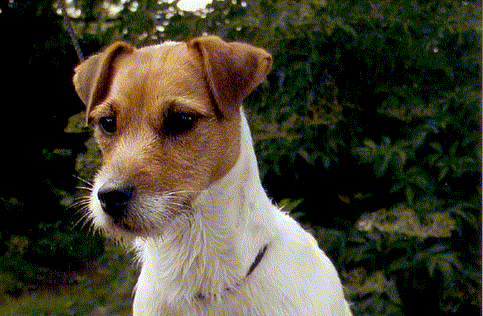History of the Breed
The young John Russell, while a student at Exeter Hall Oxford, was taking a walk across the University Parks towards Marston when he came across a milkman with a terrier "the like of which he had never encountered before", this terrier, Trump, was to become the first of his foundation stock which produced the type of foxing terrier that we know today as the Parson Russell.
Characteristics
Longer on the leg, to run with hounds, and predominently white for better visibility in dense vegetation they should be narrow enough to fold up and disappear into rabbit holes and fox earths in persuit of their quarry.
They should not be so "hard" that they attack, but should be bold enough to hold their quarry and "bay" so that they and their quarry may be located. The skin should be thick and loose to allow them to work and turn underground and the coat hard (with a dense undercoat) to keep off the weather.
Standing around 13-14 inches at the wither they are compact enough to be portable but not so small as to get underfoot. These attributes are still today essential characteristics of the breed. You may like to read The Breed Standard.
And no, they are not "yappy and snappy" but fantastic loyal companions with the "heart of a lion" who will certainly let you know if there are "visitors" about - come and see for yourself.
These little dogs are great fun to live with; but don't consider having two puppies of the same age especially from the same litter - they are certain to fight sooner or later. They are challenging, intelligent, cheerfull, naughty, funny and entertaining. Start with one and enjoy rearing your puppy and when you are certain you have the patience and your now "older" dog is steady then carefully ask yourself if you think your dog would like to share you with another? Do you have the time and patience to train a puppy that will understand "dog" better than "human" and will learn all the tricks from your older dog before listening to you.
The Breed Standard
This is the written description of the Parson Russell Terrier as laid down by The Kennel Club. It is the blueprint for the Breed and what we should have in our mind's eye when breeding or Judging.
General Appearance
Workmanlike, active and agile; built for speed and endurance. Overall picture of balance and flexibility. Honourable scars permissible.
Characteristics
Essentially a working terrier with ability and conformation to go to ground and run with hounds.
Temperament
Bold and friendly.
Head and Skull
Flat, moderately broad, gradually narrowing to the eyes. Shallow stop. Length from nose to stop slightly shorter than from stop to occiput. Nose black.
Eyes
Almond-shaped, fairly deep-set, dark, keen expression.
Ears
Small, V-shaped, dropping forward, carried close to head, tip of ear to reach corner of eye, fold not to appear above top of skull. Leather of moderate thickness.
Mouth
Jaws strong, muscular. Teeth with a perfect, regular and complete scissor bite, i.e. upper teeth closely overlapping lower teeth and set square to the jaws.
Neck
Clean, muscular, of good length, gradually widening to shoulders.
Forequarters
Shoulders long and sloping, well laid back, cleanly cut at withers. Legs strong, must be straight with joints turning neither in nor out. Elbows close to body, working free of the sides.
Body
Ribs not over-sprung. Chest of moderate depth, not to come below point of elbow, capable of being spanned behind the shoulders by average size hands. Back strong and straight. Loin slightly arched. Well balanced. Overall length slightly longer than height from withers to ground.
Hindquarters
Strong, muscular with good angulation and bend of stifle. Hocks set low and rear pasterns parallel giving plenty of drive.
Feet
Compact with firm pads, turning neither in nor out.
Tail
Customarily docked.
Docked: Length complimenting the body while providing a good handhold. Strong, straight, moderately high set, carried well up on the move.
Undocked: Of moderate length and as straight as possible, giving a general balance to the dog, thick at the root and tapering towards the end. Moderately high set, carried well up on the move.
Gait/Movement
Free-striding, well co-ordinated; straight action front and behind.
Coat
Naturally harsh, close and dense, whether rough or smooth. Belly and undersides coated. Skin must be thick and loose.
Colour
Entirely white or predominantly white with tan, lemon or black markings, or any combination of these colours, preferably confined to the head and/or root of tail.
Size
Ideal height: at withers: Dogs: 36 cms (14 ins); Bitches: 33 cms (13 ins). 2.5 cms (1 in) above or below is acceptable.
Faults
Any departure from the foregoing points should be considered a fault and the seriousness with which the fault should be regarded should be in exact proportion to its degree and its effect upon the health and welfare of the dog.
General Appearance
Male animals should have two apparently normal testicles fully descended into the scrotum
